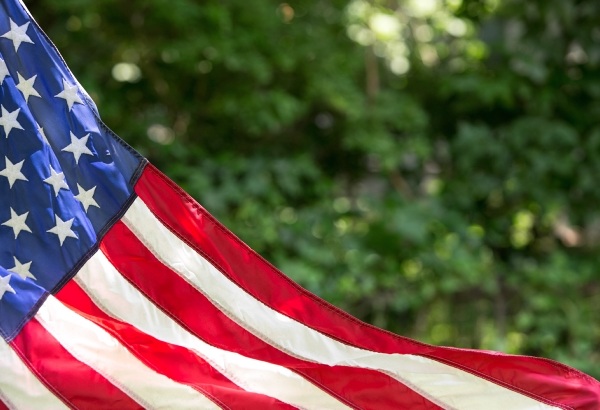
The cardinal rule about displaying the American flag is to do it respectfully.
In 1924, a committee of Army and Navy representatives met with other nation groups to work out a code of flag etiquette, establishing a set of rules for displaying Old Glory.
The code, was approved by the committee on what became Flag Day, June 14.
Congress approved the U.S. Flag Code in 1942, establishing an official etiquette for the handling and display of the U.S. Flag.
The essential rules for displaying the flag include:
- Don’t let the sun set on a flying flag. Flags can be displayed 24 hours a day, however, if they are illuminated in the dark.
- When multiple flags are displayed on a single pole or lanyard, as with state or municipal flags, the U.S. flag should always be on top.
- When flags are flown in a row, the American flag should always be on the observer’s far left.
- When displayed during a parade with other flags, the American flag should always be to the observer’s left. The flag carrier should hold the flag to his or her right side.
- When hoisting a flag on a flagpole, everyone should stand at attention facing the flag. People in uniform should salute as the flag is raised; non-uniformed observers should remove their hats and place their right hands over their hearts.
- All-weather flags can be flown during rain, though they should be taken down in high winds.
- Never dip the flag for a person, another flag or a vessel.
- Don’t let the flag touch the ground. However, the schoolyard myth that any American flag that touches the ground must be burned is false. Soiled flags that are not beyond repair should be laundered and re-flown, flag experts say. There’s even a tradition among some commercial laundries and dry cleaners to do the cleaning for free.
- Don’t fly the flag upside down except in an emergency such as a boat in distress.
- Don’t use the flag to decorate shelves, railings or lecterns. That’s what bunting is for.
There are no limits on the size of displayed U.S. flags, and it’s fairly common nowadays to see flags that could cover most of a football field. But no flag displayed alongside of the U.S. flag should be larger.
Home display
For home display, the standard practice is to use a staff that angles upward from a home’s front wall, though it’s also appropriate to hang the flag horizontally. The staff should be held in place by a bracket or screw.
The homeowner should be careful not to let the flag touch the ground or the floor. The “union,” the field of stars, should always be positioned at the flag’s peak. When the flag is displayed against a wall, the union should be at the top left.
You can fly a flag from your car, with the staff firmly attached to the right side of the car.
Flying at half staff
The U.S. president or any state governor can order flags to be flown at half-staff and set the length of their remaining that way. The rule of thumb is 30 days for the death of a president or former president, 10 days for a vice president, a chief justice of the Supreme Court or the speaker of the House of Representatives.
On Memorial Day the flag should be flown at half-staff from sunrise until noon, when it should be raised to full staff, honoring the nation’s war heroes. Other days on which the flag is typically flown half-staff are September 11, Pearl Harbor Day (December 7), and Peace Officers Memorial Day (May 15). However, the flag should not be at half-staff for Veterans Day (November 11), which is a celebratory holiday.
Flag disposal
To retire or dispose of a damaged flag, Section 176 of the U.S. Flag Code says that when “The Flag…is…no longer a fitting emblem of display, should be destroyed in a dignified way, preferably by burning.” Respectfully place the folded flag at the center of a fire, being careful not let fragments of the flag drift away. Then bury the ashes.
Before you do this, however, be sure to check local ordinances about building fires. Also, check the material of the flag; burning nylon or other artificial fibers can create a health hazard. If you have no other option, check with patriotic organizations in your community, like VFW or the Boy Scouts, about leaving the damaged flag for them to dispose of.
Clearly, the rules for using the U.S. Flag are complex, often addressing issues of handling and treatment of the flag in microscopic detail. But the rules are a mark of the seriousness with which Americans treat their bond with their native land and the reverence they have for their national flag.

No comments:
Post a Comment